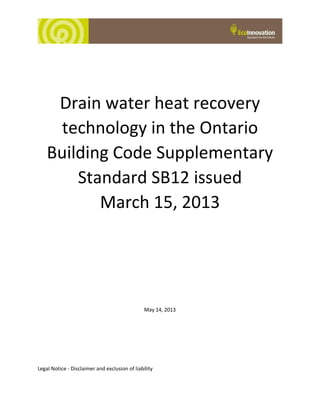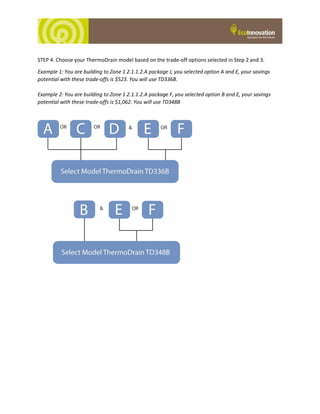Clarifying the Drain Water Heat Recovery performance requirement in the Ontario Building Code Supplementary Standard SB12 issued March 15, 2013 May 14,
- 1. Drain water heat recovery technology in the Ontario Building Code Supplementary Standard SB12 issued March 15, 2013 May 14, 2013 Legal Notice - Disclaimer and exclusion of liability
- 2. This document is provided without any representations, warranties, or conditions of any kind, express or implied, including, without limitation, implied warranties or conditions concerning this documentŌĆÖs fitness for a particular purpose or use, its merchantability, or its non-infringement of any third partyŌĆÖs intellectual property rights. EcoInnovation Technologies, does not warrant the accuracy, completeness, or currency of any of the information published in this document. EcoInnovation Technologies makes no representations or warranties regarding this documentŌĆÖs compliance with any applicable statute, rule, or regulation. In no event shall EcoInnovation Technologies, their volunteers, members, subsidiaries, or affiliated companies, or their employees, directors, or officers, be liable for any direct, indirect, or incidental damages, injury, loss, costs, or expenses, howsoever caused, including but not limited to special or consequential damages, lost revenue, business interruption, lost or damaged data, or any other commercial or economic loss, whether based in contract, tort (including negligence), or any other theory of liability, arising out of or resulting from access to or possession or use of this document, even if EcoInnovation Technologies has been advised of the possibility of such damages, injury, loss, costs, or expenses. In publishing and making this document available, EcoInnovation Technologies is not undertaking to render professional or other services for or on behalf of any person or entity or to perform any duty owed by any person or entity to another person or entity. The information in this document is directed to those who have the appropriate degree of experience to use and apply its contents, and EcoInnovation Technologies accepts no responsibility whatsoever arising in any way from any and all use of or reliance on the information contained in this document.
- 3. 1. Introduction The 2013 release of the Supplementary Standard SB12 has been made to include Drain Water Heat Recovery Technology in the prescriptive paths. Drain Water Heat Recovery is relevant to the following sections and have been modified. 2.1.1.2 Energy Efficiency for Zone 1 Buildings (5), (10), and (11) 2.1.1.3. Energy Efficiency for Zone 2 Buildings (8) 2.1.1.11 Drain Water Heat Recovery This document will help comprehend the implementation of Drain Water Heat Recovery Technology and which models are to be used based on the trade-offs and to quantify the savings associated to these trade-offs. 2. Compliance Methods Methods for achieving Energy Efficiency Compliance OBC SB12. 2.1.1. Prescriptive Compliance Packages 2.1.2. Performance Compliance Path 2.1.3.1. Other Acceptable Compliance Method ŌĆō Energy Star for New Homes Technical Specification ŌĆō Ontario. Prior to the March 2013 release of the SB12, compliance methods 2.1.2 and 2.1.3.1 was the only way to incorporate drain water heat recovery as part of the energy efficiency compliance package. Ontario Energy Efficiency Requirements Energy Star for New Homes Compliance OBC SB12 Performance Path Compliance Prescriptive Path Compliance
- 4. 3. Zones Zone 1 with less than 5000 heating degree days Zone 2 with 5000 or more heating degree days Zone 1 is separated from Zone 2 by a line that runs south of Sault Ste. Marie to Pembroke. OBC SB12 Zone 1 and Zone 2 4. Prescriptive Compliance The prescriptive compliance packages include complete building envelope packages that are deemed to meet an equivalent energy performance of an NRCan EnerGuide 80 rating. The prescriptive compliance methods include 21 building envelope packages for Zone 1 and 16 packages for Zone 2. These packages vary based on heating source, insulation, windows and furnace or heating equipment efficiency and are included in a series of table in SB-12 these tables have been included at the end of this document for easy reference.
- 5. 5. Incorporating DWHR to the Prescriptive Compliance. 5.1. Trade off Instructions for Builders in ZONE 1 If you already know what package you are building to, below are four steps to determine your savings and what model of ThermoDrain to use. STEP 1. Choose the row that matches the current package you are building to. STEP 2. Select one of the four trade-offs options that is applicable to your package. Option A, B, C or D. Note: An (X) on the row indicates that the trade-off is applicable to your package. STEP 3. Select one of the two trade-offs options that is applicable to your package. Option E or F.
- 7. STEP 4. Choose your ThermoDrain model based on the trade-off options selected in Step 2 and 3. Example 1: You are building to Zone 1 2.1.1.2.A package J, you selected option A and E, your savings potential with these trade-offs is $523. You will use TD336B. Example 2: You are building to Zone 1 2.1.1.2.A package F, you selected option B and E, your savings potential with these trade-offs is $1,062. You will use TD348B
- 8. 5.2. Instructions for Builders in ZONE 2 If you already know what package you are building to, below are four steps to determine your savings and what model of ThermoDrain to use. STEP 1. Choose the row that matches the current package you are building to. STEP 2. Select one of the four trade-offs options that is applicable to your package. Option A, B or C. Note: An (X) on the row indicates that the trade-off is applicable to your package. STEP 3. Select option D if applicable to your package.
- 9. STEP 4. Choose your ThermoDrain model based on the trade-off options selected in Step 2 and 3. Example 1: You are building to ZONE 2 Table 2.1.1.3.B package H, you selected option C. Option D is not available to your package. Your savings potential with this trade-off is $1438. You will use TD336B. Example 2: You are building to ZONE 2 Table 2.1.1.3.A package F, you selected option B and D, your savings potential with these trade-offs is $655. You will use TD348B. 6. Installation of Drain Water Heat Recovery Unit One Shower - If there is only one shower, that shower is required to be connected to a drain water heat recovery unit. Two Showers - Where there are two or more showers, drain water from at least two showers are required to be connected to a single drain water heat recovery unit or to two individual drain water heat recovery units. Three or more Showers ŌĆō At least 2 showers need to be connected to 1 or 2 DWHR units. The ThermoDrain must be installed (a) in an upright position that does not diverge more than 5 degrees from the vertical, (b) in a position such that the cold water inlet connection is at the bottom of the unit, (c) downstream of a water softener where a water softener is installed, and (d) in a conditioned space or on the warm side of the dew point of the wall assembly to avoid freezing.
- 10. 7. Conclusion ThermoDrain drain water heat recovery is one of the easiest, affordable and worry free ways of increasing a homeŌĆÖs comfort and achieving your energy efficiency goals. It is a tangible product that can be felt, touch and seen. ThermoDrain units are worry free because unlike other drain water heat recovery models on the market, they have no braze or joints where leakage can occur and have the thickest copper walls on the market.










